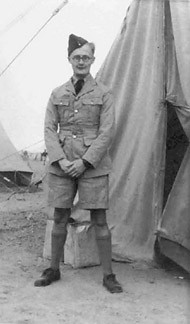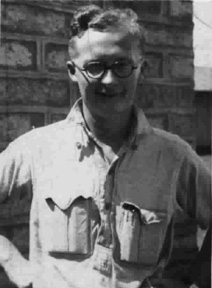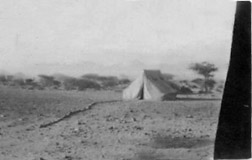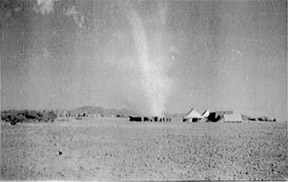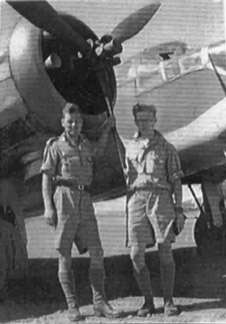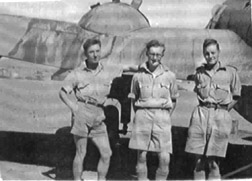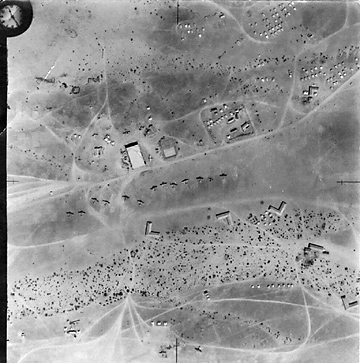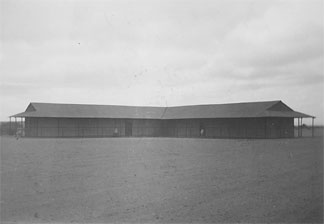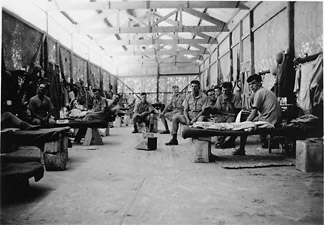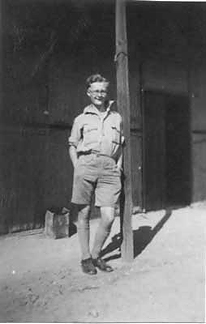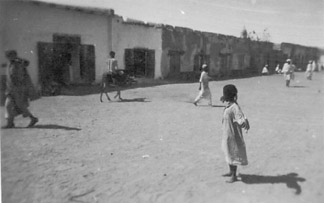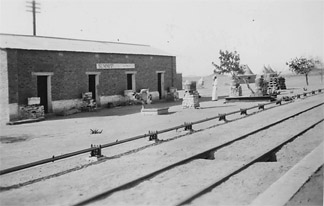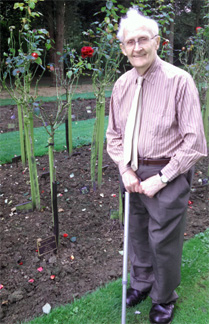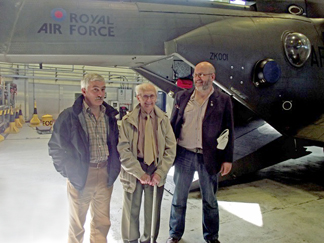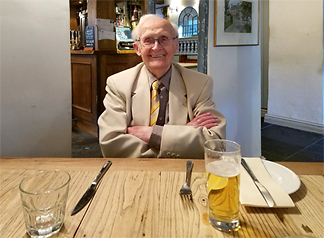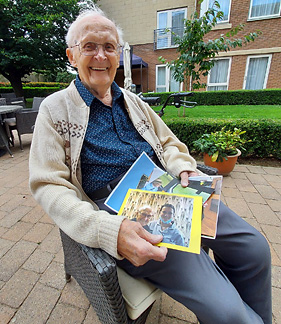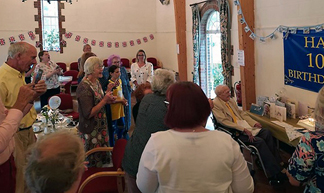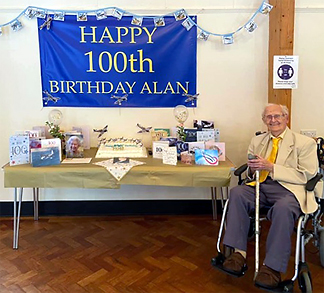 |
 |
||||||||||||||||||||
|
Alan Tatchell Conrad 1478237 RAFVR: “The RAF Tourist” 1921 to 2024 In any research project, it soon becomes clear that some terms are very specific to the topic. Apart from the obvious “211 Squadron” and “Bristol Blenheim”, there are many such in the Squadron’s history. For example, place names. Internet searches on relevant places, especially those just a little out of the ordinary, may unearth gems of material from time to time. So it was for Wadi Gazouza in the Sudan. Although my own father had been posted there with the Squadron for much of late 1941, repeated searches on that place name generally found nothing more of relevance to their story. Then in late 2001 a wonderful fresh “find” emerged. Living and working in the United States, John Conrad had been busy drafting some personal web pages to share with family at home and abroad. Among other things, there was a collection of his step-father Alan’s photos of war-time RAF service. Alan, too, had spent many months at Wadi Gazouza with 211 Squadron and 72 OTU in 1941. On enquiry, both surprised and pleased that their project had been spotted, John and Alan each replied in very kindly terms. Over all the years since (and, for John and I, on into our retirement) we’ve kept up a friendly correspondence about family news and events, and on matters 211. This page is the result. An airman’s tour Disembarked at Port Tewfik on the Suez Canal that October, from Middle East Pool he was sent on to the sand and scrub of The Sudan, where he had been posted as a clerk to 211 Squadron at Wadi Gazouza. The Squadron had been sent there for duty as a Blenheim Operations training unit, pending formation of 72 OTU.
In best working dress among the tents, soon after arrival. After his 211 Squadron and 72 OTU days in The Sudan and Kenya, Alan spent time with 230 Squadron and at Lake Koggala in Ceylon, where 205 Squadron were also stationed, both before and after their part in the Sumatra and Java debacle. Alan summarised his RAF experiences neatly as follows: “My connection with 211 squadron and Wadi Gazouza was very brief. I was posted there in October 1941 and when the squadron was moved to the Far East shortly after the Japs attacked, I was transferred to 72 OTU. At the time I was very fed up being transferred from an operational squadron but about 45 years later I read what had happened to the 211 ground staff I was thankful I had been posted. Wadi Gazouza was a very dry, dusty, sandy place and I as a lowly AC2 orderly room clerk with a total service of about five months, was about the greenest thing around. About April 1942 72 OTU was transferred to Nanyuki in Kenya (a green and pleasant land) and in June 1943 I was posted to 230 Squadron at Dar es Salaam. Their Sunderlands evacuated many from Greece in 1941 and I hope this included a lot of 211 bods [it surely did - see CFR Clark Operations in Greece]. We later moved to Lake Koggala in Ceylon and then on to Akyab and Rangoon in Burma where I left them in July 1945 having completed my four years overseas service.” In later correspondence with others, Alan went on to give a little more detail of his RAF experience, in these terms: “In October 1941 a large draft of us were posted from the Middle East Pool in Egypt to 211 Squadron at Wadi Gazouza. 211 Squadron had been badly mauled in Greece earlier in the year and had been sent down to The Sudan to operate in a training role with Blenheim bombers. Soon after Japan came into the war, 7 December 1941, the "old" 211 was posted to the Far East and the "new draft" remained at Wadi Gazouza operating as 72 Operational Training Unit.”
“In March 1942, 72 OTU moved from Wadi Gazouza to Nanyuki in Kenya and the main body of the unit was moved by sea, probably in the SS Ascanius, from Port Sudan to Mombassa and then up to Nanyuki via Nairobi. I missed that trip, as in February 1942 I went on leave in Asmara and there ended up in hospital for five weeks with jaundice followed by scarlet fever. On release I travelled to Nanyuki via Khartoum by rail, road and air. In June 1943 72 OTU was disbanded and all personnel were posted away all over East Africa and the Middle East [...] and I went to 230 Squadron at Dar es Salaam which later moved to Ceylon and then to Burma.” When Alan Conrad left the RAF in November 1946, his long and meritorious service overseas in the “back office” had been rewarded not only by steady advancement but with a Mention in despatches (London Gazette 1 January 1946). John and Alan put together a terrific little website, with timeline, photos, captions and narrative: a story far too good to miss. You’ll find the pages at http://time2meet.com/raf and Alan has most kindly agreed to share some of their photographs here. At Wadi Gazouza
A view from tent to tent at Wadi Gazouza in late 1941. While the nearby ranges are often stark, the wadi country itself is typically formed of flat sandy intermittent watercourses supporting scant vegetation bounded by low dunes.
The tentlines fell in several groups, adjacent to the low scrubby dunes immediately North and South of the strip proper with its more permanent structures, as the aerial photograph below shows.
Among Alan’s comrades were two members of the Photographic section, Messrs Conder and Fletcher, who appear with him photographed by a Blenheim IV on Christmas Day 1941.
Also well known to the late Len Abbs, Con and Fletch took many of the photographs of Wadi Gazouza that are shown on the Conrads’ site and were the source of the “unofficial” print of aerial photograph of the airfield, below. Their photos also include a number of all too rare shots of the Blenheim IVs then on charge. All three men remained with 72 OTU on the transfer to Kenya.
An absolute classic aerial photograph, with 15 aircraft in evidence. On the flightline, 12 of them twin-engined and almost certainly Blenheims. With equal confidence, of either 211 Squadron or 72 OTU. Sun, sand and circuits. This vertical shot was taken at about 11:30 in the morning sometime towards late (Winter) 1941, from the clock record and the shadows cast by the Southerly sun. The usual marginal notes are not to be seen on this scan, so no exact date. Searching the hill country around Gebeit, Sinkat, Summit and Erkowit, it took a number of attempts with Google Maps, ultimately successful, to find what remains of the original airfield at Wadi Gazouza. As a result, the aerial image above has now been re-oriented correctly, with North to the top.
The four L-shaped structures seen above in the aerial photograph are airmen’s billets, timber-framed huts with walls of hessian and matting, as Cpl Alick Goddard’s photographs of his time there with 52 R&SU from late 1940 show.
Alick Goddard’s bold, successful long exposure by available light. Allocation of hutted vs tented accommodation was no doubt keenly followed by the men. An equally successful shot of Alick’s illustrates the places of two airmen in the hut.
After 211 Squadron left around 20 December 1941, for a while there was ample accommodation. The men remaining with 72 OTU lost no time in moving in from the tent-lines! Men bound for 211 Squadron and later 72 OTU at Wadi Gazouza mainly travelled by train or by truck from Port Sudan, the line running up through the Red Sea Hills and on South towards Kassala, some 300 desolate miles away. The railway line and the old road twisted and turned about each other for some 80 miles as they ran up into the Hills and on South through Gebeit and Sinkat before reaching Summit, the railway halt and road junction well known to the 211s.
The main street of the village, the mosque tower in the background. Summit is about 8 miles further South.
Here they left the train, to travel by truck along a desert track for some eight miles over the sandy and usually dry floor of Wadi Gazouza to reach their airfield. The track is now a sealed road that passes through the old airfield sites at Summit, at Wadi Gazouza and at Carthago, to end at Erkowit in the Red Sea Hills. “...and present my true account” Kenneth, born in 1918, joined the war-time RNVR—the “Wavy Navy”. Rated Acting Paymaster’s Sub-Lieutentant in August 1943, by November he had been confirmed in that rank. In 1944, he was rated as Sub Lt (Surgery) and posted to the floating training establishment HMS Imperieuse II, initially at Gairloch in the North West Highlands of Scotland and later at Devonport in Plymouth. As Imperieuse II, the old Resolution and Revenge made up a shipboard training base for stokers (engine-room ratings). From the number of officer surgeons on the establishment list, it seems likely that a major part of the syllabus was to train men for duty as medical orderlies. Kenneth remained with Imperieuse II until war’s end and to good effect: by late November 1945, he was Lieutenant (Surgery) JK Conrad RNVR. Released from naval service in July 1946, he returned to civilian life. Sadly, he died in 1958 at the early age of 40, while the young family were living in Yorkshire. In time, the bonds of family grew anew: in 1961 Connie and Alan married, in Lancashire. From the richly entwined Conrad family life, there are now no less than six grandchildren and two great-grandchildren, connected from one side of the family or the other, on both sides of the Atlantic. Alan Tatchell Conrad retired in 1983, having worked for the same family accounting firm all his working life. His retirement gift from the firm was in due proportion: a cruise for two aboard the luxury liner Queen Elizabeth 2 to New York, staying at the Waldorf Astoria and flying home by Concorde. Connie herself was an accomplished painter. In retirement, both liked to travel. In 2002 they made a trip to Sri Lanka, associated with Alan’s RAF service there with 230 Squadron. In 2003, the couple enjoyed a cruise to the Bahamas.
In 2005, they visited John and Carol in the United States. Each year, Connie tapped out newsy letters for all and sundry at Christmas, sometimes with Alan writing a personal footnote. However, in 2009 Connie fell ill and after a spell in hospital, became increasingly frail. Cared for by Alan at home in Oxford, the two were both nearing 90. By early 2011, Connie had moved into a nursing home some three miles away, with Alan visiting daily on fair days or foul as she slipped ever further away into dementia. Lillian Constance Conrad departed this life on Saturday 18 January 2014 aged 93 years. She is greatly missed.
The red rose and plaque beside him in memory of Connie, his stance and smile undimmed down all the rich tapestry of the years since 1940. Remaining well and active since her death, Alan continued to live at home, taking the 1/2 mile walk into Witney each day for lunch: in latter days with helper, and with walking frame and stick, to sit and have the odd rest on the way there and back. Margaret, living about an hour away, visited every week or so. In America, John and his wife Carol keep in close touch and visit often, especially for big family get-togethers.
The Squadron is active as a helicopter unit, based at RAF Benson since 2009. Their current kit is the Puma HC.Mk 2: here ZK001 in the background. Alan attends the 230 Squadron Assn re-union every year. In February, June and November, Alan would set off to Weston-super-mare, for a couple of weeks break at the pretty RAFA hotel Flowerdown House on the beachfront. His June visits just happened to coincide with the annual Air Festival! The 2018 event was another cracker, by all accounts, though so warm that Alan indulged himself with taxis about the place, rather than walking.
In 2018, John and Carol came over for a Summer visit...and from the photographs, a grand time had by all. As John says, retirement is a wonderful invention. In March 2020, finding mobility less certain and with COVID-19 a risk, Alan moved to a care home in Aylesbury. There, Margaret and her family are just 15 minutes away. A practical move, as it turned out. Straight into lockdown, then, despite the precautions, in early 2021 he did catch the virus...to recover in good spirits and with minimal effects aged 99! Happy 100th Birthday, Alan!
Irrepressible! With mementoes of a close shave, this cheery shot in the gardens of Alan’s care home in Aylesbury was taken by John, soon after arriving in England for the grand event: “a small party” is in hand for the day, they tell me.
With banner, cards and the splendid cake, covered in aircraft candles. My own Very Best Wishes, to you Sir! The End at Last Sources HMSO London Gazette Supplement 1 January 1946, 18 January 1944, 13 March 1946
www.211squadron.org © D Clark & others 1998—2025 |
||||||||||||||||||||
